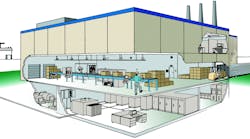Since the Electrical Pyramid's first appearance in January 1994, it has become one of Electrical Wholesaling's most requested feature articles. This analysis of the electrical wholesaling industry's channels of distribution is a welcome resource for senior marketing and management executives at established electrical companies, manufacturers new to the industry, consultants and university students in industrial distribution curriculums. They all use the Electrical Pyramid to gain insight into what makes this business tick.
Companies new to the electrical wholesaling industry also use this resource to select a channel or mix of channels to sell electrical products. For electrical manufacturers analyzing their companies' — or competitors' — distribution strategies, the Electrical Pyramid helps them compare and contrast the various channels of distribution. It's not uncommon for the Electrical Pyramid to be used as a discussion point at board of directors' meetings.
With the recent volatility of the electrical marketplace, Electrical Wholesaling's editors believed it was time to update this industry resource to provide a current snapshot of the channels of distribution in the electrical business.
THE INDUSTRY AS A WHOLE
The size of the electrical wholesaling industry surprises many people. Electrical Wholesaling's 2003 Market Planning Guide forecasts total industry sales through electrical distributors at $77.8 billion for 2004. Other sources estimate total sales a bit lower, but it's safe to say annual industry sales are somewhere between $70 billion and $78 billion.
Just how many electrical distributors are out there? Again, the answer depends on whom you ask or your definition of an electrical distributor. Electrical Wholesaling includes not only the 475 full-line distributor member firms of the National Association of Electrical Distributors (NAED), St. Louis, but also the 3,000 other full-line (pipe-and-wire) electrical distributors. Electrical Wholesaling also includes other distributors of electrical supplies, including niche distributors with specialties in residential lighting, lamps, fuses, datacom, automation products, wire and cable, and other products.
Electrical Wholesaling's 2004-2005 Directory of Electrical Wholesale Distributors lists more than 3,500 full-line electrical distributors operating at least 5,000 additional branches. That puts the “total universe” of locations operated by full-line electrical distributors at 8,500. In addition, niche distributors operate at least 1,000 more locations, according to this resource.
While these numbers by themselves are impressive, the electrical marketplace is actually much larger. In addition to traditional full-line electrical distributors and niche distributors, electrical manufacturers use more than 20 other channels to sell electrical supplies. For instance, last year Home Depot Inc., Atlanta, sold more than $3 billion in electrical products; and Lowe's, Mooresville, N.C., sold more than $1 billion in electrical supplies (based on data included in Home Channel News' 2004 listing of the Top 500 retailers).
Unfortunately, it's impossible to come up with an exact dollar amount of electrical products sold through many of these individual channels; it's more important to note that many more paths exist to the market than most people probably realize.
Despite challenges from home centers and other alternate channels of distribution, the sales of electrical products through full-line electrical distributors still dwarf the sales of electrical products through all of the other channels combined. Indeed, the sales through 4,242 locations in 15 countries of the 475 NAED member firms distributor firms alone account for nearly $30 billion of the $70-billion-plus electrical wholesaling industry.
MARKET CHANNELS
The Electrical Pyramid illustrates the profusion of different electrical product marketing channels. Although dozens of individual channels exist today, the electrical marketing industry can be sorted into several major channels or layers of distribution:
-
Full-line distributors of electrical supplies;
-
Product niche distributors such as lighting and utility specialists;
-
Service niche businesses that get into the sale of electrical products as an adjunct to the function they perform, such as energy service or demand-side management (DSM) companies, motor repair shops and lighting maintenance companies;
-
Hybrid distributors;
-
Retail or consumer-based channels, such as home centers, super stores, and hardware stores;
-
Distributors from other wholesale trades, like plumbing or industrial supplies that deal in electrical products as well;
-
Manufacturer-based channels, such as manufacturers selling direct and buy/sell reps;
-
Other channels such as Web-based companies, the gray market and manufacturers selling direct.
Within each of these layers, companies may mix and match approaches. A traditional electrical wholesaler may run a catalog business or operate a retail lighting showroom or industrial automation division. A small lighting manufacturer may operate as a distributor of lighting products as well. A number of smaller alternate channels exist, too, that really don't fall under any one category.
Each of these channels has a history all its own, a different take on the manufacturer-rep-distributor-customer equation, and its own competitive problems with other channels. Now let's take a more in-depth look at each of the various channels to market.
FULL-LINE ELECTRICAL DISTRIBUTORS
Product focus: For contractor-oriented distributors, a broad line of construction-related electrical/electronic products for new construction and renovation work in residential, commercial, industrial, institutional and government applications. Industrially-oriented distributors tend to carry motors, drives, controls, automation systems and other products for the installation and repair of manufacturing equipment.
Primary customers: Electrical contractors, plant or building maintenance personnel, purchasing agents across a wide range of businesses.
Approximate number: At least 8,500 locations operated by 3,500-plus firms.
National association and other key industry groups: Approximately 475 companies are members of the National Association of Electrical Distributors (NAED), St. Louis, Mo.
More than 1,300 distributors of electrical supplies belong to buying/marketing groups: Affiliated Distributors Inc., King of Prussia, Pa.; the IMARK Group, Oxon Hill, Md.; and Equity/EDN, formed through a 2003 merger of Equity Electrical Associates Inc., East Walpole, Mass., and Electrical Distributors Network, Concord, Ohio. UPA, Sanford, Fla., which had courted full-line electrical distributors in the past, now focuses on lighting specialists.
Don't underestimate the clout of the buying groups. More than half of EW's Top 200 are members of a buying group, primarily A-D and IMARK. A few are Equity members.
Two other key trade groups in the electrical wholesaling industry are the National Electrical Manufacturers Representatives Association (NEMRA), Tarrytown, N.Y.; and the National Electrical Manufacturers Association (NEMA), Rosslyn, Va.
NEMRA offers independent manufacturers' reps and their vendors a forum to discuss joint marketing and sales goals, as well as resources that help reps run their businesses more profitably, while NEMA's members focus on developing technical standards for products, as well as standards for electronic communication.
What's happening. Consolidation continues — although its pace has slowed considerably within the electrical industry. Unlike some other distribution-based industries, the electrical wholesaling business is still relatively fragmented.
The 200 largest electrical distributors account for about 48 percent of the industry's sales, according to Electrical Wholesaling's Top 200 analysis, which appears annually in the June issue. Most industry observers agree this percentage will increase dramatically, but it will still take years until the electrical industry consolidates as much as the pharmaceutical or electronics industries, where three or four distributors control the vast majority of sales. Still, each year, a few electrical distributors disappear from the Top 200 list as larger firms grow still larger through acquisitions.
Full-line electrical distributors are by far the largest single channel for electrical supplies. They can be divided into different sub-channels, or types of companies:
National chains
Four national chains are at the top of the Electrical Pyramid: Graybar Electric Co., St. Louis; WESCO Inc., Pittsburgh; Consolidated Electrical Distributors (CED) Inc., Westlake Village, Calif.; and GE Supply Inc., Shelton, Conn. From 1995 through 2001, the four chains steadily grew market share by actively acquiring new locations and starting up new branches. The national chains' collective market share peaked at 18 percent in 2001. With combined 2003 sales of $11.9 billion, today these companies account for about 16 percent of total industry sales.
Super-regional chains
These firms operate in two or more different regions of the United States, but can't yet be considered truly national distributors. The super regional chains are Border States Electrical Supply, Fargo, N.D.; Crescent Electric Supply Co., East Dubuque, Ill.; Hagemeyer North America, Atlanta; Rexel Inc., Dallas; McNaughton-McKay Electric Co., Madison Heights, Mich.; and Sonepar USA, Berwyn, Pa. The super-regional chains have combined sales of more than $5 billion. Hughes Supply Inc., Orlando, could also be considered a super-regional distributor, with its acquisition earlier this year in Las Vegas of Standard Wholesale Supply Co., its first outside of the southeastern United States.
Regional electrical distributors
These companies typically have five or more locations. Electrical Wholesaling's “Top 200” ranking had more than 130 electrical distributors with at least five locations.
Other electrical distributors
It's a bit ironic that the majority of full-line electrical distributors get swept into the category of “other electrical distributors.” With one to four supply houses, these “other” distributors are the majority when it comes to mass numbers. More than 3,000 full-line distributors of electrical supplies fit into this category.
NICHE DISTRIBUTORS
More than a dozen distinct types of niche distributors exist. They specialize in many different products, including residential lighting fixtures, motors, automation products, lamps, industrial controls, wire and cable, energy-conservation products, utility products, VDV products, fuses and electrical insulation materials.
Some of these specialty distributors are strictly distribution firms and do not handle any design, installation or repair capabilities. Other niche distributors, such as automation specialists, energy-service companies and motor repair shops, offer other services along with distributing products. Although they sell electrical supplies, these repair/service distributors primarily focus on providing a complete service solution to their customers; product sales may not be their primary function. Part Two of this article will cover the biggest specialty distribution channels in the electrical industry, and offer capsule summaries of the operating strategies of some of the largest specialists.
HYBRID DISTRIBUTORS
Hybrid distributors distribute electrical supplies, but they don't operate like traditional electrical distributors. For the purposes of this analysis, hybrid distributors are large distribution companies where electrical products are part of a much broader portfolio, or firms with a truly unique blend of products, installation capabilities or service offerings.
Although a bit out of the mainstream of the electrical wholesaling industry, these companies offer manufacturers of electrical and electronic equipment additional channels to market, compete with full-line electrical distributors in many instances and are therefore important “bricks” in the electrical pyramid. Anixter Inc., Glenview, Ill.; Fastenal Inc., Winona, Minn.; and W.W. Grainger Inc., Lake Forest, Ill., are the three largest hybrid distributors selling electrical supplies into this market.
ANIXTER BROTHERS INC.
With well over $1 billion dollars in wire and cable sales, and its position in the datacom voice, data and video (VDV) market, Glenview, Ill.-based Anixter is a market channel unto itself. Founded in 1957, this company and its estimated 5,000 employees continue to break new ground in the datacom market.
Some industry observers say this company and Graybar Electric Co., St. Louis, are the only two distributors in the datacom market with a national presence. All of the other distributors tend to be more regional in nature. Although the company is well-known these days for its expertise in the VDV market, when brothers Alan and William Anixter, founded the business 47 years ago, the company concentrated on building wire, power cable and control wiring.
Product focus: Virtually all wire and cable, with a particularly strong emphasis on VDV cabling products.
Primary customers: Electrical contractors and end users in all commercial, industrial, institutional and government facilities.
Number of locations: 150.
Estimated sales volume: $2.6 billion in 2003 sales.
FASTENAL INC.
Although electrical products aren't this fasteners giant's main interest, the Winona, Minn.-based company has built a sizeable electrical business and is actively adding electrical products to the 150,000 stock-keeping units (SKUs) it stocks in its 1,441 locations. Threaded fasteners such as screws, nuts, and bolts account for about half of sales and the 150,000 items in its mega catalog.
Product focus: Fasteners and a broad range of MRO, industrial and electrical supplies. The company stocks 10,000 stock-keeping units in electrical supplies.
Primary customers: MROs and industrial customers.
Number of locations: 1,441 locations in 50 states.
Estimated sales volume: $994.9 million in total company sales (electrical sales not available).
W.W. GRAINGER INC.
No one else in the electrical marketing industry does business quite like Grainger. From the satellite dishes on top of its 396 locations that beam orders back to its Illinois headquarters, to its sophisticated order-handling and next-day-delivery shipping systems, Grainger has embraced some of the cutting-edge technologies of our time and put them to work in the marketplace.
The company estimates that 70 percent of all U.S. businesses are within 20 minutes of a Grainger branch. Over the last three years, the annual sales volume of orders processed through www.grainger.com dwarfs the total sales of all but the very largest electrical distributors. Grainger's online sales for 2001 to 2003 were $332.5 million, $419.5 million and $478.6 million, respectively. The company's new ad campaign, “Call, Click or Stop By,” reflects the importance it places on online shopping.
Product focus: Historically, a wide range of electrical, industrial, safety and related products for maintenance and repair operations for the MRO market; more recently a focus on energy-efficient electrical products and construction-oriented products. The company used to sell just motors and related products.
Primary customers: Industrials, and now electrical contractors. The company also targets hospitals and medical offices.
Number of locations: 396.
Estimated sales volume: $4.66 billion in 2003 total sales. Electrical products account for approximately 20 percent of sales.
RETAIL CHANNELS
After full-line electrical distributors, the next most visible way for electrical products to get to market is the retail channel. Home Depot, Atlanta; Lowe's, Mooresville, N.C.; other home centers; and mom-and-pop hardware stores account for the lion's share of the electrical product sales in the retail channel. Department stores and other retail shops sell some lighting products, too. Part two of this article will cover the retail channels in much more depth.
OTHER CHANNELS
In the late 1990s, many industry observers thought Web-based companies that offer customers 24-hour access and overnight delivery of a basketful of products would be the most important new channel to challenge the electrical wholesaling industry. That may one day still be the case, but electrical distributors have survived the first assault by Web-based competitors because customers still value their core services — local stock and product expertise.
Along with Web-based competition, other channels for the sale of electrical products do exist. The alliances between distributors from different trades to service the maintenance, repair and operations (MRO) product needs of industrial customers with single-source, integrated-supply solutions developed during the 1990s as an alternate channel.
One must also consider another channel that has been around for much longer than distributor alliances or Web-based competition: direct sales from manufacturers. It's a tough channel to get a fix on because manufacturers don't like to discuss it much.
Many manufacturers have national accounts or sell some of their output to other manufacturers for inclusion in the product they make. Direct sales seem to occur most often on large automation, roadway or municipal lighting projects. Although the manufacturers sell these jobs direct, they sometimes place the paperwork through distributors.
An offshoot of direct sales is the situation in the lighting market, where some manufacturers' independent agents take on some of the order-processing and occasionally the stocking responsibilities of the distributor and deal directly with end users.
One variation of this arrangement is the “buy/sell” rep, where a rep takes title to (buys) goods from a manufacturer and sells them either to a distributor or an end user.
FUTURE ALTERNATE CHANNELS
What other channels for electrical supplies may develop in the future? Home Depot is already a channel unto itself in the electrical market. But rumors persists that the company may want to buy its way into the electrical distribution business with the purchase of a large distributor.
It wouldn't be the first time the company bought a distributor in this market — Big Orange bought Georgia Lighting Supply Co., Atlanta, in 1999.
Industry observers are still waiting for a new market channel to rise from the ashes of the fallen dot-coms, as entrepreneurs learn from the errors of the first wave, and build on what worked. Some industry observers speculate that electrical distributors may form partnerships with dot-coms where they would service the orders for electrical products on a national or regional basis that are generated by the online storefronts that dot-coms would build.
To be continued. Part two will focus on niche distributors and the retail channel.








